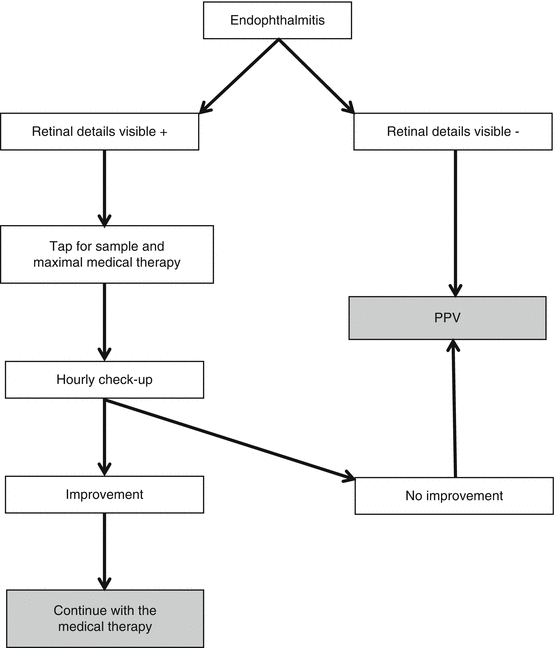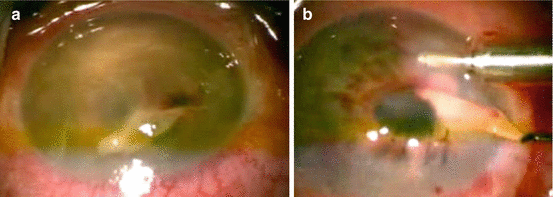(1)
St. Johns, FL, USA
(2)
Helen Keller Foundation for Research and Education, International Society of Ocular Trauma, Birmingham, AL, USA
(3)
Consultant and Vitreoretinal Surgeon, Milos Eye Hospital, Belgrade, Serbia
(4)
Consultant and Vitreoretinal Surgeon, Zagórskiego Eye Hospital, Cracow, Poland
45.1 General Considerations
45.1.1 Etiology
Endophthalmitis may be postoperative,1 posttraumatic, and endogenous; it is mostly caused by bacteria but may also be fungal.
Q&A
Q
Can endophthalmitis occur after closed-globe surgery?
A
In principle, no; in practice, yes. The simple explanation for this paradox is accidental perforation of the sclera with the needle during SB or squint operation.
The vast majority of the cases are acute2; the chronic cases are typically caused by fungi or organisms such as Propionibacterium acnes after cataract surgery.
Posttraumatic endophthalmitis is unique in its presentation since the typical signs are often masked by the injury, thus making the diagnosis more challenging. The organism is often more virulent; it is therefore even more important to intervene on an emergency basis and attempt to do a complete surgery (CEVE, see below).
45.1.2 Clinical Diagnosis
The following are typical signs and symptoms.3
Drop in visual acuity.
Pain.
Corneal edema.
Hypopyon and fibrin in the AC.
Small pupil.
Reduction in, or loss of, the red reflex.
If the retina is visible at all, it shows tortuous and sheathed blood vessels, stress hemorrhages, and widespread edema.
The diagnosis can be confirmed by obtaining a sample from the AC or via a vitreous tap.4
45.1.3 Timing
There is no other surgical indication in ophthalmology when the initiation of treatment is as urgent as in endophthalmitis.
Pearl
The easiest part of the management of a patient with acute endophthalmitis is timing. Medically and legally, it is very difficult to justify any delay in commencing the treatment, whichever treatment route is chosen.
As part of the management, the ophthalmologist should warn the patient against lying in bed. Being upright reduces the risk of the heavy purulent material settling on the macula.
45.1.4 Treatment Options and Management Philosophy
There are two basic options: medical and surgical.5 In the first case the ophthalmologist chooses the “safe” route and follows an “evidence-based” recommendation6: if the VA is greater than LP, intravitreal and periocular antibiotics are given, but no systemic antibiotics are used and surgery is not performed.
In my opinion the presence of pus inside the eye represents a surgical indication.7 I also believe that a condition, which can rapidly lead to irreversible loss of vision, deserves all the weapons at the ophthalmologist’s disposal to be utilized against it.8 This includes the use of systemic antibiotics – and, primarily, surgery.
Vitrectomy is my default option, as long as the patient’s systemic condition permits it.9 The only exception is an endophthalmitis so early that retinal details can still be visualized. In such a case I am willing to use medical treatment (the maximum possible; see Table 45.1), but keep the patient under very close observation: hourly self-check10 for pain and visual deterioration (see Fig. 45.1 for the decision-making process).


Table 45.1
Medical treatment in endophthalmitis*
Route of administration; schedule | Drug | Dose (in a volume of) |
|---|---|---|
Intravitreala; the initial injection is given before or at the conclusion of surgery; repeated as needed | Vancomycin | 2 mg (0.1 ml) |
Ceftazidime | 2.25 mg (0.1 ml) | |
Dexamethasone | 0.4 mg (0.1 ml) | |
Intravenous; every 12 h | Vancomycin | 1 g |
Ceftazidime | 1 g | |
Subconjunctival; daily or as needed | Vancomycin | 25 mg (0.5 ml) |
Ceftazidime | 0.1 g (0.5 ml) | |
Dexamethasone | 12 mg (3 ml) | |
Topical; hourly or as needed | Moxifloxacine | 0.5% |
Ofloxacin | 0.3% | |
Tobramycin | 0.3% | |
Steroid | Depends on availability; use the strongest one | |
Pupil dilator | Atropine, tropicamide |

Fig. 45.1
Decision-making tree to select the treatment in endophthalmitis. Medical treatment is continued even if PPV is performed. See the text for more details.

Fig. 45.2




Cleaning the AC in an eye with traumatic endophthalmitis. (a) In this patient with a 3-day-old traumatic endophthalmitis, the corneal wound has not been sutured since the patient did not seek help after the injury. The AC filled is with nontransparent material; it is not possible to determine how much the cornea would interfere with visibility during vitrectomy. (b) The corneal wound was closed with full-thickness sutures, the epithelium scraped, and an AC maintainer placed. The fibrinous membrane is being removed with forceps, the iris is now visible, and only a few minutes have elapsed since the taking of the picture seen on (a)
Stay updated, free articles. Join our Telegram channel

Full access? Get Clinical Tree


